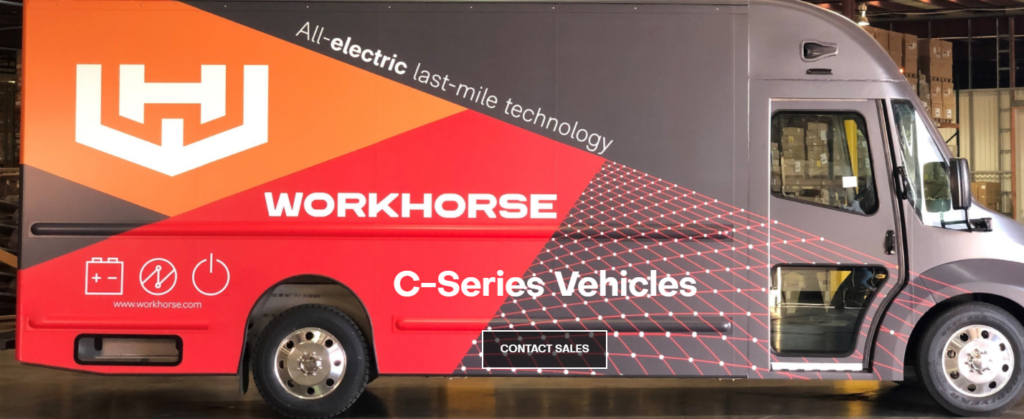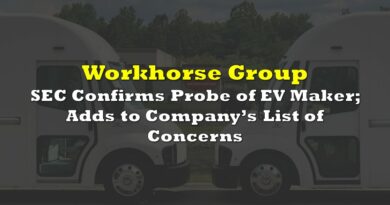Workhorse Group Adds Department of Justice Investigation to Long List of Uncertainties
On November 5, the Wall Street Journal reported that it had reviewed documents confirming that the U.S. Department of Justice (DOJ) has opened an investigation into Workhorse Group Inc. (NASDAQ: WKHS), an Ohio-based company which produces drone-integrated electric vehicles (EVs) for the last-mile delivery sector. This probe adds to a long list of uncertainties about the company.
The market has recognized this situation as the stock has lost about 85% of its value since early February, and more than 50% just in the last four months. However, Workhorse still has an equity market capitalization of about US$810 million even though its cash burn rate reached US$49 million in 2Q 2021 and seems likely to increase materially from that level.
Workhorse is contending with three main issues. First, on September 22, the company announced a suspension of deliveries of its flagship C-1000 electric step van and a recall of the 41 units it had already delivered. According to a filing with the National Highway Traffic Safety Administration, problems with the vehicle include flaws in its electrical system and exterior lighting. Also, the C-1000’s windshield wipers and wheels and rims did not meet safety standards.

Management determined that production and design changes are required. Once these changes to these items are completed, testing must be done and the changes must conform to Federal Motor Vehicle Safety Standards. The testing is expected to be completed in 4Q 2021. Workhorse has not released any estimate of the cost of the design alterations to the vehicle or the cost of the recall.
Second, on September 30, CEO Richard Dauch announced the departures of CFO Steve Schrader and COO Rob Wilson. Mr. Schrader was replaced by an interim CFO; the COO position was eliminated. Mr. Dauch, who joined Workhorse only on July 29, is of course entitled to surround himself with a management team of his choice, but ousting the CFO and the COO raises eyebrows.
Third, on September 1, a short seller, Fuzzy Panda Research, reported that it received a letter dated June 30 from the enforcement division of the U.S. Securities and Exchange Commission (SEC) saying that it is still “actively” investigating Workhorse. The company has told the SEC it has made “misstatements” to safety regulators.
On September 15, Workhorse withdrew its complaint at the U.S. Federal Court of Claims regarding the U.S. Postal Service’s (USPS) February 2021 decision to award a ten-year contract to design and build its next generation of delivery vehicles to Oshkosh Corporation (NYSE: OSK). Oral arguments on the complaint had been set to begin that day. Workhorse had claimed that the USPS removed its prototype from consideration over a “safety incident” caused by a USPS driver’s error.
The cash outlays associated with the C-1000 design change and recall exacerbate Workhorse’s financial situation. Its cash burn rate (operating cash flow shortfall plus capital expenditures) reached US$49 million in 2Q 2021, up from US$36 million in 1Q 2021 and US$34 million in 4Q 2020. In turn, the company’s cash balance fell nearly US$50 million in 2Q 2021 to US$157 million as of June 30, 2021. Workhorse plans to release its third quarter earnings on November 9.
| (in thousands of US $, except for shares outstanding) | 2Q 2021 | 1Q 2021 | 4Q 2020 | 3Q 2020 | 2Q 2020 |
| Net Sales | $1,203 | $521 | $652 | $565 | $92 |
| Operating Income | ($22,723) | ($16,454) | ($15,049) | ($9,815) | ($6,985) |
| Operating Cash Flow | ($46,364) | ($34,904) | ($32,637) | ($19,888) | ($9,931) |
| Capital Expenditures | ($3,281) | ($1,265) | ($1,665) | ($2,640) | ($510) |
| Cash – Period End | $156,611 | $205,075 | $46,818 | $80,223 | $26,198 |
| Debt – Period End (A) | $200,900 | $182,200 | $199,111 | $123,228 | $116,647 |
| Shares Outstanding (Millions) | 123.4 | 123.3 | 121.9 | 115.0 | 89.3 |
Over the last couple weeks, investors have bid up some start-up EV players, most notably Lucid Group, Inc. (NASDAQ: LCID), but also Fisker Inc. (NYSE: FSR). If investors were to expand that field, Workhorse could potentially be included. Another factor could come into play if retail investors were to decide that Workhorse is a potential meme stock: about 39% of its float is sold short.
Highlighted by the DOJ investigation, the Workhorse business model is characterized by uncertainty on a variety of fronts, particularly its worsening cash flow position. In turn, the stock has lost half its value over just four months, but given all the issues it faces, Workhorse’s enterprise value level of around US$850 million still may be too high.
Workhorse Group Inc. last traded at US$6.74 on the NASDAQ.
Information for this briefing was found via Edgar and the companies mentioned. The author has no securities or affiliations related to this organization. Not a recommendation to buy or sell. Always do additional research and consult a professional before purchasing a security. The author holds no licenses.




